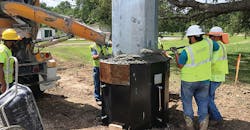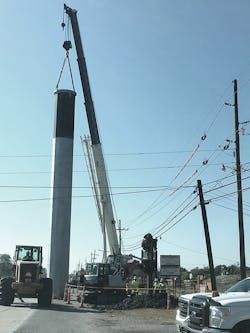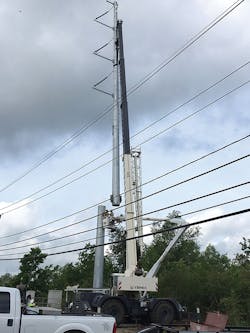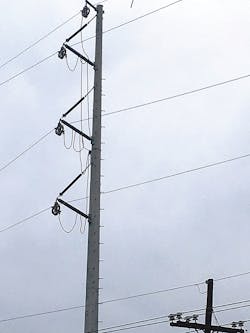Entergy Energizes New 230-kV Transmission Line
For the better of a decade, Entergy Louisiana planned to build a new transmission line between two substations, but discovering an acceptable route through a developed corridor was like threading a needle. Constructing the new 230-kV line between the Oakville and Alliance substations was the third phase of the Southeast Louisiana Improvement project (SELA3), which followed the construction of two substations and another 230-kV transmission line.
After evaluating multiple line routes and considering the opinions of all stakeholders, the decision was made to locate the majority of the new line along a state highway, a path that presented its own set of challenges.
Trying to design and construct an overhead line in such a narrow, crowded corridor proved to be a technical challenge. The engineering and construction team had to find a suitable spot for each structure that would not hit the underground infrastructure or the existing overhead distribution line, while staying a safe distance from the highway travel lane.
To solve this puzzle, Entergy Louisiana hired Burns & McDonnell as the prime engineering, procurement and construction contractor. The team worked closely together to design an acceptable 10.5-mile line route, which included about 7 miles within the Louisiana Highway 23 right-of-way. Plaquemines Parish officials, landholders and stakeholders all agreed to the plan, and the design, engineering and construction team got to work on the project.
Relocating Utilities
Once it completed design work for the new route for the transmission line, Burns & McDonnell hired a team of subcontractors including Auger Services Inc. for the foundations, Chain Electric for the poles and wires, and Woodson Inc. for the vegetation clearing.
Before constructing the new line, the team had to first eliminate several interferences. The work included moving portions of Entergy’s distribution line to increase electrical clearances, asking the parish to relocate 4 miles of a water main, and requesting other utilities to move their gas and phone lines.
In addition to obtaining enough clearances, Entergy also had to coordinate with landowners and state and local agencies to get permission to block driveways, temporarily close highway lanes and control traffic while setting structures and stringing wire. It became especially challenging near the highway, where the project team had to get right-of-way from several hundred different tract owners to build the line. The team tried to accommodate landowners’ requests, such as by building the structures a certain distance from property lines or driveways.
To minimize interruptions and maximize productivity, the linemen preframed many of the structures on the ground and then stood them up fully assembled. They used their bucket trucks for final finish work. Because they were working in such a developed area, it required a significant amount of preplanning to save time and minimize highway lane closures.
Constructing a New Line
The new line provides an additional transmission feed to the lower part of the parish, which is situated at the fringe of Entergy Louisiana’s transmission system. Now that the new line is in service, reliability to parishes in southeast Louisiana is improved.
Also, the line is providing additional capacity in an area that is rapidly growing. For example, the parish has experienced both industrial and business development. While the upper end of the parish is highly developed, Entergy Louisiana has been working with state and local economic development partners to bring new investment and jobs to the southern portion of the narrow parish, which sits astride the last 70 miles of the Mississippi River as it empties into the Gulf of Mexico
Within this parish, Phillips 66 has an oil refinery, which is located directly across from Entergy’s Alliance substation. The refinery and other large industrial customers require reliable power in the local area.
Building Steel Structures
Within southeastern Louisiana, the crews had to build structures not only in poor soil conditions but also design and construct them to withstand severe storms and hurricanes. The structures are designed to withstand winds of up to 150 mph.
Rather than setting wood poles for transmission lines, Entergy commonly installs steel poles on steel caissons, hollowed socketed or base-plated foundations, which because of poor soil can weigh up to 60,000 lb and can be buried up to 70 ft. The linemen drive the steel foundations into the ground with a vibratory hammer and then set the single steel poles on top of the foundations.
With this approach, crews can minimize soil excavation and use of concrete. As a result, this approach is often more cost-effective and efficient. These foundations are now used on the majority of Entergy Louisiana’s transmission projects in south Louisiana due to the time and labor savings, particularly in areas with wetlands or high water tables.
To install these steel poles and foundations, the field crews use two large cranes — one to pick up the foundation and the other to handle the vibratory hammer. Each structure has a large construction footprint, so it’s necessary to plan out the project carefully. Fortunately, the line contractor had a lot of experience shoehorning the two large cranes into the narrow right-of-way to drive in the massive foundations.
Also, this construction method eliminates the need for guy wires because the steel structures are self-supporting. Using a crane, the linemen can drive the foundation and then set the poles, which are 80 ft to 115 ft in height and up to 5 ft in diameter. Eliminating the need for guy wires avoids the problems they sometimes pose. Guy wires require more land, are susceptible to damage, and are difficult and time-consuming to maintain, so Entergy has opted to move to a pole and foundation design that allows poles to stand on their own, making them more reliable over the long term.
Improving Reliability
To further enhance the resiliency of the line, the linemen installed ACSS high-temperature conductor, which has a smaller diameter than typical conductors of the same capacity, and reduces wind loading on the wires. The crews also set the transmission structures an average of 400 ft apart, which is closer together than a typical 230-kV line. Within this project’s narrow right of way along Hwy 23, the crews pushed the wire closer to the highway and installed longer arms on several structures to avoid the possibility of electrical lines swinging on to customers’ properties. With this plan, Entergy did not have to acquire additional rights-of-way from customers’ front yards.
In addition, the linemen constructed taller structures. Oftentimes, normal 230-kV structures measure 80 ft to 90 ft tall, but the structures on the stretch of line along the highway were up to 115 ft tall. To get the buy-in from all the stakeholders, Entergy agreed to move the existing adjacent 34.5-kV feeder onto the new steel structures, which resulted in the structures being around 20 ft taller than normally required. On the line, the linemen also installed OPGW shield wire, which allows high-speed fiber-optic communications between the two substations.
The line crews also installed steps on the pole from the top of the structure down to just below the lowest insulator. That way, if necessary, a helicopter can land a lineman on top of the pole for future maintenance access, particularly after a storm event when roads may be blocked by debris. Most likely, however, the linemen will use bucket trucks to maintain the poles, many of which are in an easily accessible location along the highway.
As part of the last portion of the project, linemen will construct roughly 7 miles of new 34.5-kV distribution line on the lower portion of the new steel transmission structures along Hwy 23. All customers currently served by the existing distribution line on older wood poles along that section of Hwy 23 will be served by the new distribution line. Entergy Louisiana expects to complete work on the distribution lines in the next eight to 10 months.
By completing a key portion of the $60 million reliability project, the project team, stakeholders and other parties are excited about putting in the line. Before the line was energized, it was difficult, if not impossible, to get outages on other lines, and many other projects were waiting on its completion before they could move forward. Now that the new 230-kV line is energized, it has opened the door for construction of other planned projects to begin while increasing reliability throughout the community. ♦
Mario Ceravolo is a project manager for Entergy in the capital projects transmission group. He has been with the company for the last 18 years.
About the Author
Mario Ceravolo
Mario Ceravolo is a project manager for Entergy in the capital projects transmission group. He has been with the company for the last 18 years.





